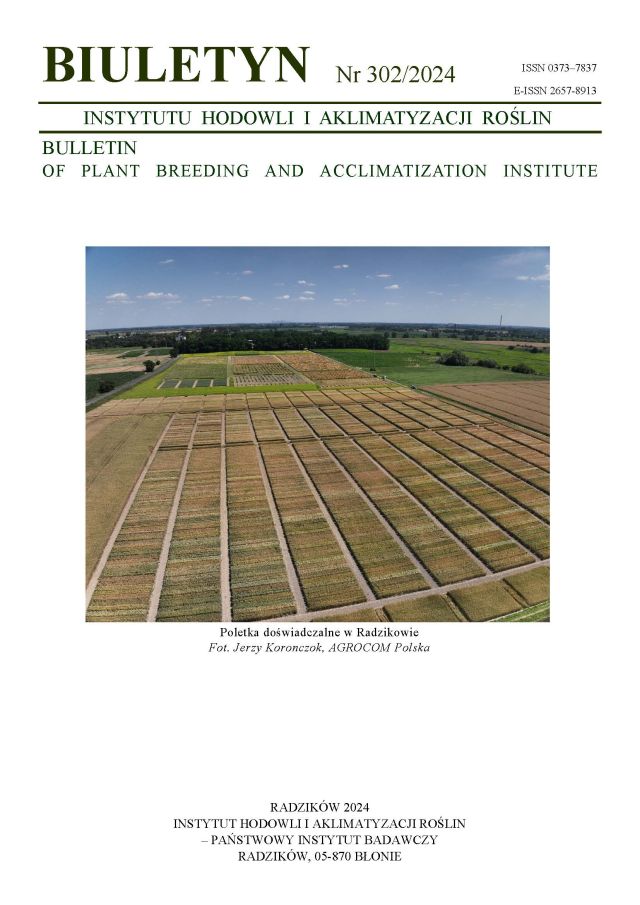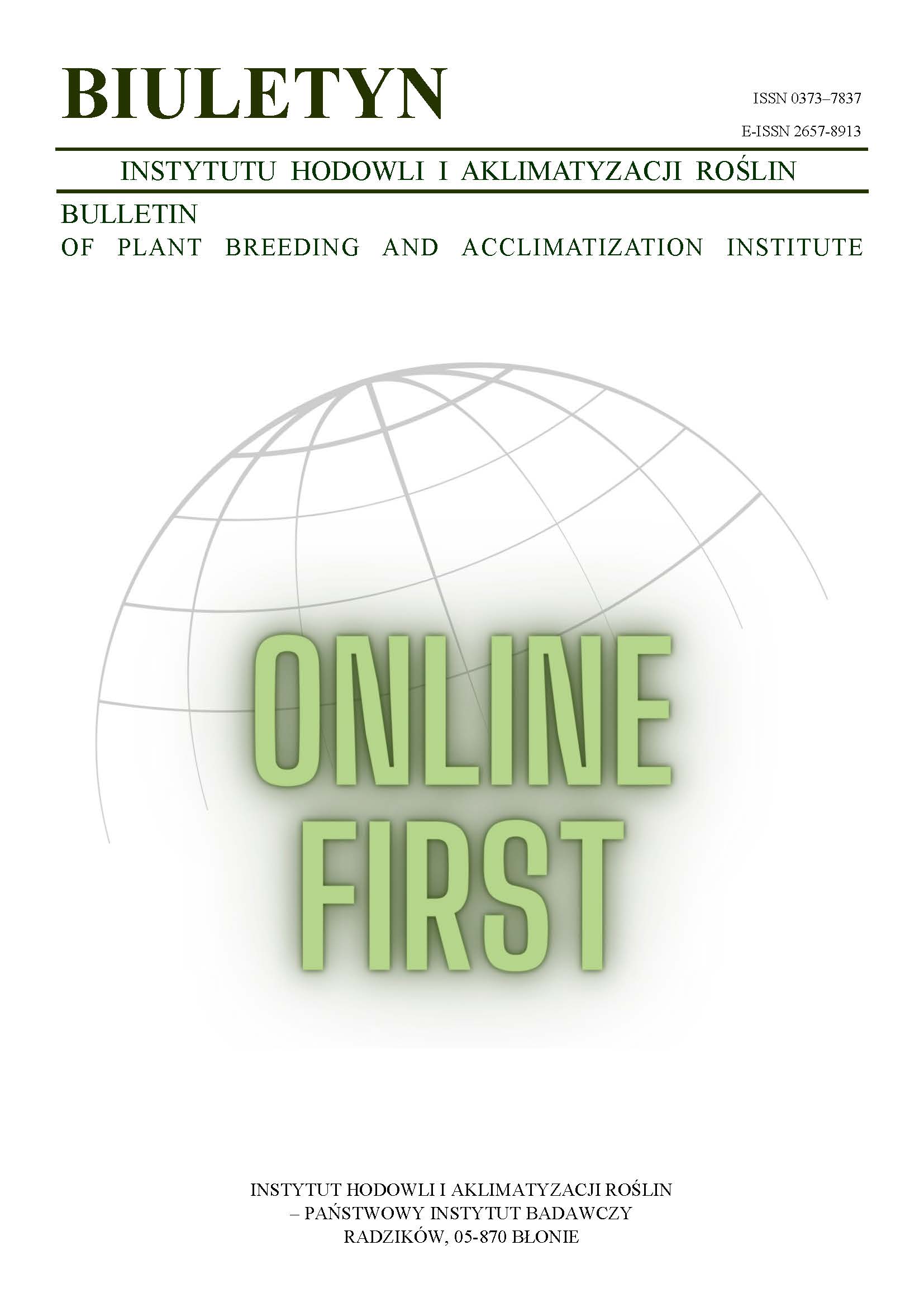The role of green manures, in form of undersown cover crops, and straw in sugar beet cultivation
Part II. Yield and biometric characteristics of sugar beet roots
Danuta Buraczyńska
iro@uph.edu.plKatedra Szczegółowej Uprawy Roślin, Akademia Podlaska w Siedlcach (Poland)
Abstract
In the years 1997–2000, the studies were carried out on the effect of biomass of undersown cover crop compared with farmyard manure (the control treatment without organic mass, farmyard manure, undersown cover crop: black medic, Westerwolds ryegrass, black medic + Westerwolds ryegrass) and barley straw (the treatment without straw and the treatment with straw application) on yield and quality characteristics of sugar beet roots. The field experiment was set up in the split-block design with three replications. In most cases, sugar beet fertilization with farmyard manure and biomass of undersown cover crop, in comparison with the combinations without organic fertilization, increased the sugar root and leaf yield, root weight, length and diameter as well as the protrusion of roots. The straw application significantly increased leaf yield and protrusion of roots. The impact of the biomass of black medic and the mixture of black medic and Westerwold ryegrass on the yield of sugar beet roots and leaves as well as on the weight, length and protrusion of roots was similar to the effect of farmyard manure. The sugar and sodium content in the sugar beet roots did not depend on the applied fertilization. The alpha-amino nitrogen in the sugar beet roots obtained from the combinations fertilized with farmyard manure and the biomass of undersown cover crop was significantly higher compared with the control treatment. The fertilization with the biomass of black medic and Westerwold ryegrass significantly increased potassium content in the sugar beet roots compared with the control treatment.
Keywords:
molasses producing components, root biometric characteristics, straw, sugar, sugar beet, undersown cover crop, yieldReferences
Asmus F., Vőlker U. 1984. Einfluss von Strohdűngung auf Ertrag und Bodeneigenschaften in Fruchtfolgen mit unterschiedlichem Getreideanteil. Arch. f. Acker u. Pflbau. 28 (7): 411 — 417.
Google Scholar
Banaszak H., Gutmański I., Kostka-Gościniak D., Nowakowski M., Szymczak-Nowak J. 1998. Wpływ udziału buraka cukrowego w płodozmianie, stosowania słomy i miedzyplonu na plonowanie i zdrowot¬ność roślin. Acta Acad. Agricult. Tech. Olst., Agricultura 66: 239 — 246.
Google Scholar
Batalin M. 1962. Studia nad resztkami pożniwnymi roślin uprawnych w łanie. Rocz. Nauk Rol., Ser. D: 5 — 154.
Google Scholar
Buraczyńska D., Ceglarek F. 2004. Znaczenie nawozów zielonych z międzyplonów wsiewek i słomy w uprawie buraka cukrowego. Cz. I. Zachwaszczenie plantacji buraka cukrowego. Biul. IHAR 234: 171 — 180.
Google Scholar
Ceglarek F., Gąsiorowska B., Zarzecka K. 1995. Plonowanie i wartość technologiczna buraka cukrowego w zależności od zróżnicowanego nawożenia organicznego i nawożenia mineralnego. Zesz. Nauk Rol. WSRP Siedlce 39: 57 — 71.
Google Scholar
Gandecki R., Malak D., Śniady R., Zimny L. 1999. Plonowanie buraka cukrowego przy zróżnicowanym nawożeniu organicznym i wzrastających dawkach azotu mineralnego. Zesz. Nauk. AR Wrocław 361, Konferencje XXII: 189 — 195.
Google Scholar
Gutmański I. 1988. Obsada roślin a produktywność buraków cukrowych i pastewnych. Mat. Konf. Nauk. „Obsada a produktywność roślin uprawnych”, IUNG Puławy: 59 — 74.
Google Scholar
Gutmański I., Mikita J. 2000. Wpływ obornika i dawek azotu mineralnego na wydajność i jakość przetwórczą korzeni buraka cukrowego oraz na zawartość azotanów w profilu glebowym w okresie wegetacyjnym. Folia Univ. Agric. Stetin 211, Agricultura 84: 121 — 126.
Google Scholar
Gutmański I., Szymczak-Nowak D., Kostka-Gościniak D., Nowakowski M., Banaszak H. 1998. Wpływ obornika, słomy i międzyplonów ścierniskowych na plonowanie buraka cukrowego przy zróżnicowanej koncentracji jego uprawy w płodozmianie. Rocz. AR Poznań CCCVII, Rol. 52, z. 1: 263 — 271.
Google Scholar
Harasimowicz-Hermann G. 1998. Wartość następcza łubinów, ich miejsce w zmianowaniu oraz w siedliskach pozarolniczych. Mat. Sem. Nauk. „Łubin w rolnictwie ekologicznym. Łubin — Białko — Ekologia”, ODR Przysiek: 31 — 40.
Google Scholar
Kalinowska-Zdun M., Wyszyński Z. 1999. Kryteria jakości korzeni buraka cukrowego i ich zmienność. Mat. Konf. Nauk. KSUR „Środowiskowe i agrotechniczne uwarunkowania jakości płodów rolnych”, Fundacja „Rozwój SGGW”, Warszawa: 151 — 161.
Google Scholar
Kopczyński J. 1986. Wpływ nawozu zielonego z poplonu żyta ozimego i rzepaku na plonowanie oraz zmiany niektórych cech jakości buraka cukrowego. Rozprawy 101, AR Szczecin.
Google Scholar
Kopczyński J. 1996. Kierunki zmian niektórych cech jakości korzeni buraka cukrowego pod wpływem współdziałania nawożenia organicznego i azotowego. Zesz. Nauk. AR Szczecin 172, Rol. 62: 249 — 257.
Google Scholar
Kuduk C. 1975. Wpływ nawożenia słomą gleb lekkich na zawartość w niej podstawowych składników pokarmowych. Rocz. Nauk Rol., Ser. A, 101, 1: 73 — 82.
Google Scholar
Mazur T., Sądaj W. 1999. Działanie wieloletniego nawożenia obornikiem, gnojowicą i nawozami mineralnymi na plon roślin i białka. Zesz. Probl. Post. Nauk Rol. 465: 181 — 194.
Google Scholar
Miczyński J., Siwicki S. 1960. Międzyplony nawozowe w uprawie buraków cukrowych. Cz. II. Wsiewki międzyplonowe. Rocz. Nauk Rol., Ser. A, 83, 2: 311 — 348.
Google Scholar
Nowakowski M., Gutmański I., Szymczak-Nowak J., Kostka-Gościniak D., Banaszak H. 1996. Wpływ nawożenia obornikiem, słomą oraz roślinami poplonowymi na plon i zdrowotność buraka cukrowego przy zróżnicowanej koncentracji jego uprawy w płodozmianie. Zesz. Nauk. AR Szczecin 172, Rol. 62: 429 — 435.
Google Scholar
Ostrowska D., Kucińska B. 1998. Wpływ wzrastającego nawożenia azotem oraz różnych form nawozów organicznych na plon i jakość buraka cukrowego. Rocz. AR Poznań CCCVII, Rol. 52, z. 1: 273 — 278.
Google Scholar
Wesołowski M., Bętkowski M. 2001. Reakcja buraka cukrowego na warunki gospodarki bezobornikowej. Fragm. Agron. 4 (72): 78 — 86.
Google Scholar
Siwicki S. 1971. Wartość nawozowa międzyplonów i obornika w uprawie buraków cukrowych. Biul. IHAR 6: 59 — 71.
Google Scholar
Słowiński H., Prośba-Białczyk U., Pytlarz-Kozicka M. 1995. Wpływ nawożenia na rozwój roślin i narastanie plonu buraka cukrowego. Zesz. Nauk. AR Wrocław 262, Rol. LXIII: 21 — 29.
Google Scholar
Szymczak-Nowak J., Kostka-Gościniak D., Nowakowski M., Gutmański I. 2002 a. Systemy uprawy buraka cukrowego na różnych glebach. Cz. VI. Wybrane pomiary biometryczne. Biul. IHAR 222: 349 — 354.
Google Scholar
Szymczak-Nowak J., Nowakowska H., Sitarski A., Tyburski J. 2002 b. Wpływ nawozów organicznych na plonowanie i zdrowotność buraka cukrowego. Zesz. Probl. Post. Nauk Rol. 484: 683 — 690.
Google Scholar
Authors
Danuta Buraczyńskairo@uph.edu.pl
Katedra Szczegółowej Uprawy Roślin, Akademia Podlaska w Siedlcach Poland
Statistics
Abstract views: 63PDF downloads: 21
License
Copyright (c) 2004 Danuta Buraczyńska

This work is licensed under a Creative Commons Attribution-ShareAlike 4.0 International License.
Upon submitting the article, the Authors grant the Publisher a non-exclusive and free license to use the article for an indefinite period of time throughout the world in the following fields of use:
- Production and reproduction of copies of the article using a specific technique, including printing and digital technology.
- Placing on the market, lending or renting the original or copies of the article.
- Public performance, exhibition, display, reproduction, broadcasting and re-broadcasting, as well as making the article publicly available in such a way that everyone can access it at a place and time of their choice.
- Including the article in a collective work.
- Uploading an article in electronic form to electronic platforms or otherwise introducing an article in electronic form to the Internet or other network.
- Dissemination of the article in electronic form on the Internet or other network, in collective work as well as independently.
- Making the article available in an electronic version in such a way that everyone can access it at a place and time of their choice, in particular via the Internet.
Authors by sending a request for publication:
- They consent to the publication of the article in the journal,
- They agree to give the publication a DOI (Digital Object Identifier),
- They undertake to comply with the publishing house's code of ethics in accordance with the guidelines of the Committee on Publication Ethics (COPE), (http://ihar.edu.pl/biblioteka_i_wydawnictwa.php),
- They consent to the articles being made available in electronic form under the CC BY-SA 4.0 license, in open access,
- They agree to send article metadata to commercial and non-commercial journal indexing databases.
Most read articles by the same author(s)
- Danuta Buraczyńska, The role of green manures, in form of undersown cover crops, and straw in sugar beet cultivation. Part III. Content of macroelements in plants , Bulletin of Plant Breeding and Acclimatization Institute: No. 246 (2007): Regular issue
- Danuta Buraczyńska, Feliks Ceglarek, The role of green manures, in form of undersown cover crops, and straw in sugar beet cultivation , Bulletin of Plant Breeding and Acclimatization Institute: No. 234 (2004): Regular issue
- Danuta Buraczyńska, Fertilizing effect of farmyard manure and undersown cover crops on sugar beet , Bulletin of Plant Breeding and Acclimatization Institute: No. 228 (2003): Regular issue














